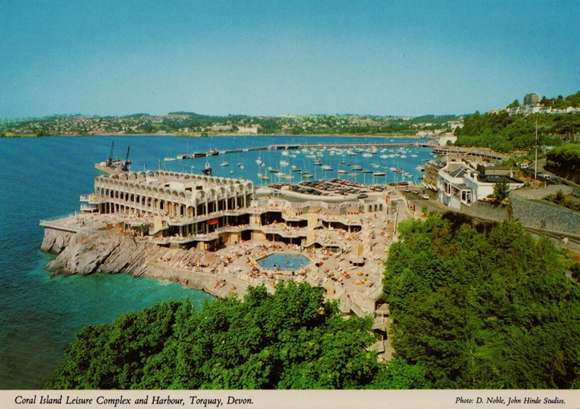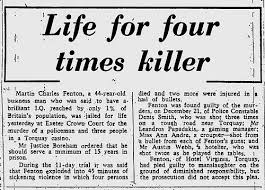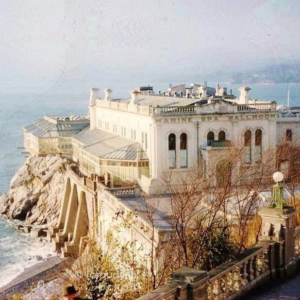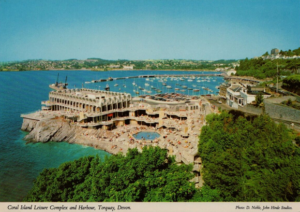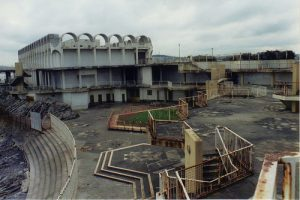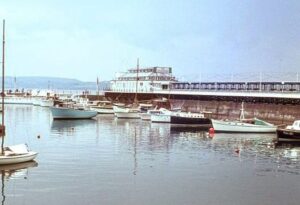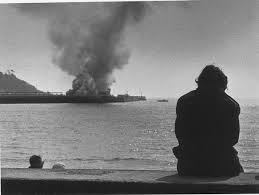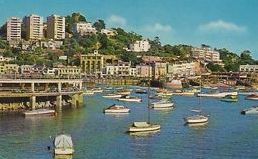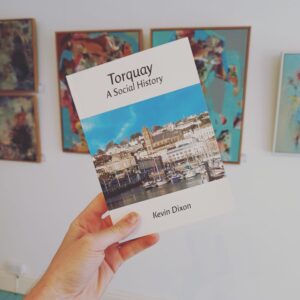Not everyone had a great holiday experience in post-war Torquay. Some complained about crowded roads, unreliable trains, unpredictable weather, low-quality food and drab accommodation. In 1947 the journalist James Pope Hennessy called in:
“The whole town was swarming with holidaymakers, only they did not seem to be making holiday. There was something unduly oppressive in the empty, questing faces of the crowds that shuffled and shambled through the sunless, hot but steep and windy streets. They had nothing to do, it seemed, because there was nothing for them to do”. 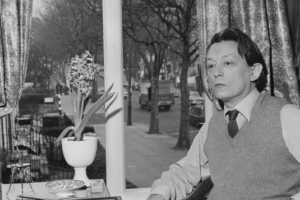
The travel writer James Pope Hennessy; not a fan of post-War Torquay
On the other hand, few knew any better… until the alternatives came along.
Perhaps the day it all changed for the British seaside resort was 5 May 1962. This was the first flight of the new airline ‘Euravia’, taking families on an all-inclusive Spanish vacation. There had been package tours before, but rising wages and higher employment now offered new types of holiday. At the same time, Beeching was withdrawing the inexpensive trains that had long delivered holidaymakers from the cities.
The traditional resorts faced further competition from campsites while visitors now expected more than just basic accommodation. And, as car ownership increased, there were more day-trippers while the larger hotels were offering lower rates to coach parties. Early casualties of the shift in the resort’s fortunes were boarding houses and small hotels, a feature of Torquay’s social landscape for a century.
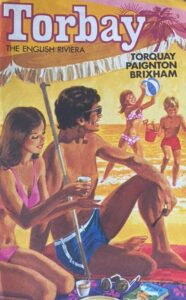 The influence and power of the seaside business model then diminished as ownership of tourist accommodation moved from the local to the national, and finally to the international. Meanwhile, well-regarded family-owned stores were also being displaced by indistinguishable national chains.
The influence and power of the seaside business model then diminished as ownership of tourist accommodation moved from the local to the national, and finally to the international. Meanwhile, well-regarded family-owned stores were also being displaced by indistinguishable national chains.
Action needed to be taken to fill the widening gaps in trade. For some these measures were to be found in the time-honoured replication of the more-sophisticated Mediterranean resorts. Other entrepreneurs worked on a smaller scale and embraced the brash and modern. This was the old dialectic, to remain upmarket, or to cater for the spending power of the masses. As ever, disputes arose between short-term economic realities, which were seen to be forcing the town down-market, and enduring principles. These were fought over in the media and could be seen breaking out over emblematic issues, particularly the loss of heritage and green field sites.
Replicating a cote d’azur skyline
Even the long-standing replication of the famed French and Italian resorts risked going too far. Viewed as especially contentious were the strivings for modernity which was held responsible for much-loved Victorian and Edwardian villas being replaced by tower blocks, so changing the skyline forever.
Most, on the other hand, failed to notice gradual changes. But then two incidents in rapid succession, coming from opposite ends of the social spectrum, shocked the town.
On 21 December 1973 four people were killed at the Carlton Casino. Then, on 3 October 1974 four died, including the perpetrator, in a gun attack on Abbey Road’s Roebuck House. It was the first of these tragic incidents that so undermined Torquay’s carefully cultivated self-image and which raised serious doubts about the town’s aspirations.
On 21 December 1973 four people were killed at the Carlton Casino.
Casinos had always been redolent of the sophisticated Riviera. They were an amenity that could confirm that Torquay could equal the glitz and glamour of the Cote d’Azur; the urbane tuxedo a fine substitute for the shabby old seaside socks-and-sandals combination. The Carlton tragedy ended that dream. Oldway and the Pavilion would not, in consequence, become casinos. The promise had always been that Torquay could be a Devonian Cannes, a place known for its sophistication, a home to the rich and famous serviced by luxury hotels and restaurants. For the more sceptical there was now another Mediterranean city that offered a less attractive model for the future; Marseilles, densely populated, lawless and poverty-stricken.
Social and economic change inevitably moves more rapidly than the built environment and the shift in the British vacation left a legacy of the out-dated, the rundown, or just abandoned. This was, of course, nothing new. There were always gaps in the fabric of the town, but they were soon filled by the next wave of entrepreneurs catering for the tourist or resident. But now replacement took longer, sometimes years longer, before a new use could be found.
The Marine Spa, built in 1857
Built in 1857, the Marine Spa was a monument of grand architecture which included a ballroom, concert hall, and sunlit conservatory, while underneath was a large public swimming baths. As times moved on the Spa gradually lost its popularity, its final demise ultimately signalled by the 1971 tragic drowning of a young boy. Although there had been plans to replace the Spa since the 1960s, the incident expedited the demolition of the much-loved building.
Coral Island opened in 1977
The site was eventually redeveloped by Joe Coral of bookmaker’s fame. Opening in 1977, this was the modern and exciting ‘Beacon Leisure & Entertainment Centre’, or ‘Coral Island’, leaving only the sun terraces to remind of the old Spa. Yet Coral Island struggled to fulfil its promise as an all-year venue and the building closed altogether in September 1988.
For more than a decade Coral Island’s rotting carcass loomed over Torquay
For more than a decade Coral Island’s rotting carcass loomed over the resort, the failed attraction symbolising everything that was seen to be wrong with Britain’s outmoded coastal communities. A visiting Daily Telegraph journalist scornfully remarked that, “More architectural murders have been committed here than in all of Agatha Christie’s novels.”
There were regular proposals to revive the husk of Coral Island, but the crumbling complex was eventually demolished in 1997. The site was subsequently taken on by Paignton Zoo as ‘Living Coasts’ marine aviary, another attraction that would ultimately fail.
The wooden ‘Islander Bar’ on Princess Pier….
Other legacies of the town’s golden age would evolve, be left to decay or perish, some in dramatic fashion. In a further metaphor for fading resorts, in April 1974 fire gutted the wooden ‘Islander Bar’ on Princess Pier. It was never rebuilt, a sad conclusion to the long saga of Torquay’s confused love-hate relationship with the Victorian pier.
…. was destroyed by fire in April 1974
Less immediately noticeable was the piecemeal stripping of Victorian and Edwardian assets.
The pre-Raphaelite artist Edward Burne-Jones ‘The Nativity and The King and the Shepherd’ hung on the north and south walls of St John’s for just over a hundred years before being sold
St John’s Church was once the setting for two huge paintings. However, the church needed a new roof and in 1989 both were sold to composer Andrew Lloyd Webber, ending up in Pittsburgh’s ‘Carnegie Museum of Art’, far from their intended setting.
The town’s population was also being recast. For generations Torquay had attracted the affluent, but more recent newcomers were often on fixed or declining incomes, living longer and needing more support from local services.
Lacking opportunities the population balance altered as ambitious young people left in a diaspora of the talented, many believing they had no future in their hometown.
By then many of Torquay’s celebrated five-hundred villas were already anachronisms. Converted decades before into tourist accommodation, what became of these substantial properties depended on their location.
If a villa had a good view, it was either replaced or converted into luxury apartments, often to be sold to wealthy retired incomers. Without a view, they became less expensive flats, care homes or Houses of Multiple Occupation, a number with far-away landlords. The latter concentrated the economically vulnerable in the town centre and contributed to ongoing cycles of deprivation. Hence the title of ‘Costa del Dole’. As always, sea views were a signifier of social class with ‘view or non-view’ an indicator of economic security, lifestyle, health and ultimately life expectancy.
Torquay wasn’t alone in this. As the tourist base contracted during the late twentieth century, the season shortened, the visiting clientele changed, and investment diminished, leaving many resorts facing a spiral of decline. Indeed, just as in so many other towns based on a single industry, the community faced trauma as its core trade diminished and its identity fractured.
Beyond the conspicuous decay, however, another reinvention was taking place. This time away from the urban centre and the harbourside, largely unnoticed amongst the narratives of decline.
Torquay: A Social History by local author Kevin Dixon is available for £10 from Artizan Gallery, Fleet Street, Torquay, or:
https://www.art-hub.co.uk/product-page/torquay-a-social-history-by-kevin-dixon


